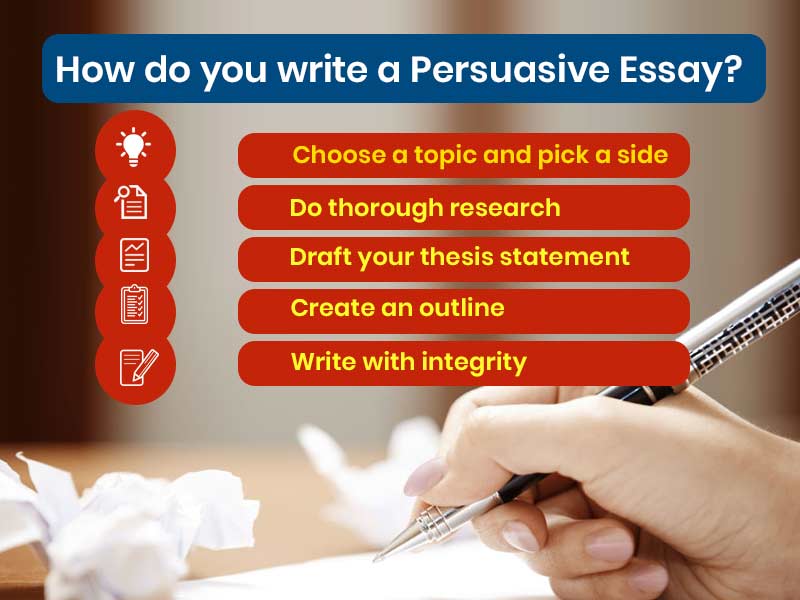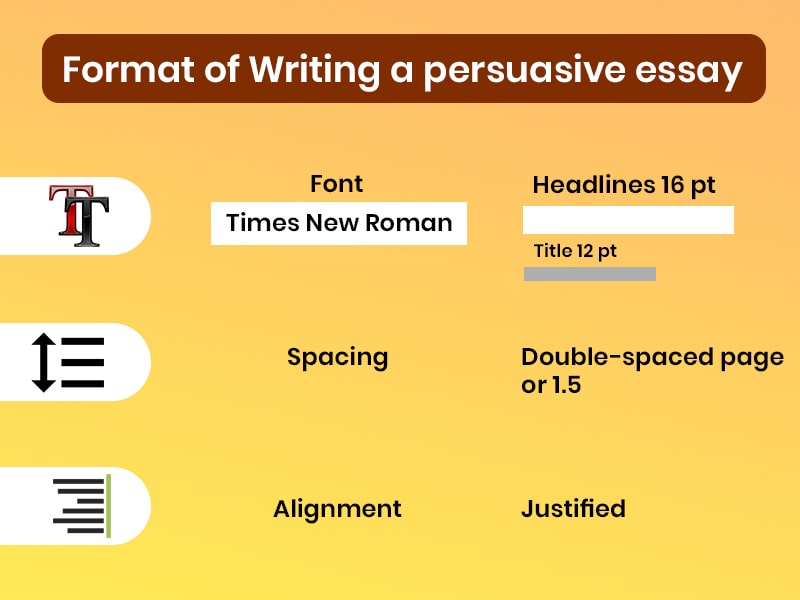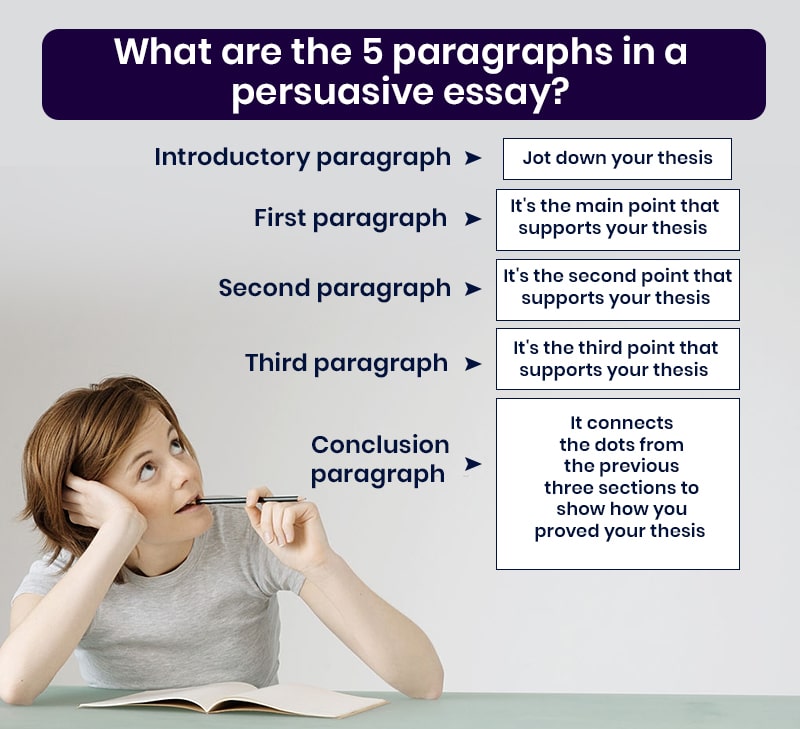The following is a persuasive essay outline.
It’s hard to create something that will interest someone else in just a few paragraphs or pages.
But persuasive essays are different! Unlike Rhetorical Analysis essay, Persuasive essays use emotional manipulation to grab the reader’s attention about an issue and change their opinion on it.
A writer can do it with words, but it becomes more convincing when you provide evidence for your case.
In this blog post, we’ll talk about techniques on how to write an essay outline that will help influence your reader so they’ll agree with you!
Table of Contents
How do you write a Persuasive Essay?

Rhetoric refers to persuasive or impressive language, which has a convincing or remarkable effect on the audience being addressed.
Here you can find Steps to Write an Explanatory Essay
Instructors will often assign students to write a persuasive paper about an issue, and such a writing process is typically meant to persuade the reader.
For example, a strong argument can use both emotional language and cold facts when presenting its case to convince the audience of your position.
Whether or not you’ve taken a course in rhetoric, students can apply the principles of persuasion when writing an effective persuasive essay.
If you want to learn How to Create Persuasive Essay Outline, click here.
If you want to learn How to Create an Outline for an Argumentative Essay, click here.
Choose a topic and pick a side.
The most important aspect of persuasive essay writing is choosing an interesting topic which you care about.
Because you will use your research to argue your side of the topic, it helps to have something that matters to you at its core.
Having some emotional attachment or sentimental value associated with the idea will also make arguing in favor of your argument easier and more poignant.
A good thing about picking an emotionally intriguing topic is you’ll know quite a bit about what people are discussing when joining in on conversations or later researching information – as opposed to topics less close to home.
Moreover, if you want to get the top ideas for choosing the best narrative essay topics, read out the article.
Do thorough research
Argumentation is a fundamental part of rhetoric. To convince your reader to comply with you, you must know the opposing side’s argument.
One way to strengthen your support evidence is by insisting on research and thoroughly understanding both arguments.
It’s important to use academic journals and reference materials to help give insight into the topic at hand.
With a complete understanding of your topic, you’ll be able to address any doubt that may cross a reader’s mind with prepared, thoughtful responses. Explore every aspect of writing the essay on How to Start an Essay About Yourself.
Draft your thesis statement
The most important element of persuasive writing is the thesis statement.
The thesis should tell readers what argument you are trying to get them to accept and how you will convince them that the argument is sound.
If you don’t have a forceful thesis, your essay won’t be effective, which should include “what” and “how” components.
While the “how” component will become more evident as the essay progresses, your thesis statement will build an organizational pattern for your essay that presents your position.
Create an outline
Researching your paper will give you a clear view of your argument.
To know How to Write a Short Essay Example, click here.
Think thoroughly about the strengths and weaknesses of your argument—would it be practical to introduce it with some information or a paragraph to create interest?
Instead, use research from the outset for sections that aren’t strong but still add up to the overall effectiveness of your ideas.
List out all major claims and what research supports each point not to miss anything important within your arguments.
A logical and straightforward argument is the ultimate goal of a persuasive essay.
You can achieve this objective by constructing an outline, like an Harvard Outline, that details your arguments in a clear chronological order. In the meanwhile explore the short guide on satire essay topics.
Write with integrity
There are strong arguments across the three main zones of a persuasive piece–ethical reasoning, logical reasoning, and emotional reasoning–the message will be difficult to disagree with. Master rhetoricians know this balance does not come easily.
Ethically it must not mislead or misrepresent its argument.
Logically it should progress in a way that makes sense entirely depending on facts and shreds of evidence from other sources for such attributes as needed but in proportionate measure.
Finally, emotional feelings occupy the space meant for motivations. However, this may vary in degree based on audience.
If your readers are more drawn to emotions than logical considerations, you can stir up their passion while making sure they don’t lose track of your ethics and logic as they’re being swept away by the power of your words. Also check out some excellent opinion essay examples in our next blog.
You should emphasize the importance of such evidence and use deliberate repetition to compel your audience. The key is to find a harmony among these three elements, writing with integrity and empathy.
Explore the basic differences between Argumentative Vs. Persuasive Essays!
Save Your Time & Money By Ordering Essays from Us
How do you write a Persuasive essay outline?
Preparing an essay outline is a vital step for writing persuasive essays.
Creating and organizing your thoughts with the outline makes it easier to form sentences as you write.
A standard persuasive essay structure will consist of three main elements: an introduction, body, and conclusion.
Each element has a fuction that is essential for the paper.
Meanwhile, you can go through the blog here to learn the top-notch 40+ opinion essay topics.
You must cite it according to one of the common citation styles – such as APA or MLA.
A persuasive essay outline is as follows:
Introduction
A persuasive essay introduction should start with a hook, be straight to the point, engaging, and concise.
The primary purpose of these opening paragraphs is to define your topic, arguments, and position to grab readers’ attention.
Start by revealing some supporting background info on your thesis topic so that the audience is interested in what will come next.
Body
A persuasive paper should be logical and make a strong argument.
It can be several paragraphs that each focus on the point of view with supporting evidence.
But it is more convincing and detailed when the body paragraphs are logically arranged according to the topic.
When writing a persuasive essay, make sure each of the main body paragraphs presents an argument supporting evidence and a concluding sentence.
This conclusion will hook your position on this point while finishing off or transitioning to another paragraph to make a new point for another aspect of your topic.
Conclusion
Be sure to reinforce the critical points in your essay writing through repetition.
The conclusion is meant to give closure by reiterating the main points and providing a final statement.
Persuasive essays should offer a summary of key points to leave readers with food for thought.
With its power, persuasive essay writing is logical and clear to the reader by leaving out any extra idea to support their opinion.
Therefore, the next time you think about “how do I write my essay?”- Make sure to visit this blog!
Format of writing a persuasive essay.

To clarify the persuasive essay outline in a detailed manner, a writer can follow a persuasive essay format.
Here is a template that you can follow,
-
Font
12 pt. Times New Roman, 16 pt. for title and headlines
-
Spacing
Double-spaced page or 1.5
-
Alignment
Justified
Persuasive Essay Structure

Introduction
- Hook Sentence
- Background information
- Thesis statement
Body paragraphs
- Argument 1 – Supporting evidence & concluding sentence
- Argument 2 – Supporting evidence & concluding sentence
- Argument 3 – Supporting evidence & concluding sentence
Conclusion
- Summary of the key points
- Restate thesis statement
- Importance of argument
- Call to action
Word count
Minimum 500-2000 word count, depending on the topic and teacher’s requirements.
In the persuasive essay outline above, you can find out how to perfect your skills in persuasive writing, even if it is for a national contest or college persuasive essay.
When documentation of facts and support material is present, the title will make readers more confident in its arguments.
Speaking of reading sources, if you want to view this copy offline, download the PDF here.
What are the 5 paragraphs in a persuasive essay?

For your five-paragraph essay, here’s a good persuasive writing outline to complete:
- Introductory paragraph. Jot down your thesis.
- First paragraph. It’s the main point that supports your thesis.
- Second paragraph. It’s the second point that supports your thesis.
- Third paragraph. It’s the third point that supports your thesis.
- Conclusion paragraph. It connects the dots from the previous three sections to show how you proved your thesis.
You can use this outline for persuasive essay, articles, blog posts, and even your college persuasive essay writing.
How do you write a persuasive essay?
College level persuasive essay outline takes some work but following these steps will make it easier.
Three components need to be discussed to write an excellent persuasive essay.
Here is a persuasive essay outline template that you can follow:
Introduction
A good persuasive essay outline worksheet starts with an introductory paragraph.
The purpose of writing a good introduction paragraph is to engage, convince and persuade the readers to read your paper.
- Use a hook
If you plan on writing your argumentative essay with a hook, it’s best to use an interesting fact related to your topic. The hook can be in the form of a question, exclamation, or even a statement.
This way, the reader will be interested in hearing more about what you have to say and the rhetorical techniques.
For example, writing facts and arguments in your paper will hook the students to know more about the topic, as it may relate to them.
Similarly, you can also introduce yourself early on by including background information about you or how you feel about your ideas.
Using this process sets up for later credibility in your writing because readers know more about who you are.
Write strong statements and provide supporting proof to your argument.
Sometimes it is necessary to be sturdy with your point to convince the reader of your opinion.
Vague sentences and ambiguous words will only confuse the reader; be direct and powerful enough to persuade them to understand what you mean.
- Focus on your audience
Before you start writing a persuasive essay outline, make sure to research your audience and determine what will be the most adequate way of persuading them.
For example, when writing for children and adults, you need to consider different things. Likewise, there are various people with other ideas and sensitivities; not all will agree with specific issues.
Think about your audience before deciding which topic would be appropriate.
A persuasive essay outline can help you structure a compelling argument by providing the reader with valuable information. Other helpful tips include:
- Informing your readers about the topic.
- Using background details to improve their interest.
- Not flooding them with too much information.
Thesis Statement
A thesis statement is scripted at the end of an introduction.
This statement outlines your point of view as to why you have chosen to write about this topic in light of its relevance to other current events.
The thesis is the staple of your essay and will be referenced throughout the whole paper.
Start with a solid introductory sentence that intriguingly presents the topic, including supporting arguments, evidence, and practical examples.
Body Paragraph

Body paragraphs are an essential and necessary part of a persuasive essay outline. Each body paragraph provides the audience with more information about the topic, using facts and supporting evidence to give reasons and logic for their ideas.
The content in the body paragraphs will prove your stance and determine whether readers will side with or against you.
- Provide facts
It is easy to persuade someone to provide credible examples in your essay from real life related to that specific issue.
- Statistics
Just like facts, statistics will also be solid proof to support your argument. Make sure that you are collecting authentic research and statistics related to the topic.
- Use Quotes
It will increase the reliability of your writing if you have some solid and authentic name mentioned and quoted in your essay. Additionally, it will display your level of being informed and credibility about the respective topic.
- Examples
Give examples in your paragraph that are relevant to the essay topic. A Real-life Example helps readers relate to the situation and see your perspective.
A template of your paragraph body outline is provided below. It should look something like this,
Paragraph 1
Topic Idea 1 – outline evidence
Paragraph 2
Topic idea 2 – outline evidence
Paragraph 3
Topic idea 3 – Outline evidence
Conclusion
In your conclusion, restate the thesis statement and essential points that bolster the argument.
Keep in mind that stay focused on what you have already written. Do not create or add anything new; it will fail!
Add what has been already discussed, and established, in the essay and stick with it.
To make the conclusion more effective, add a personal example related to the topic and engage readers by leaving something to ponder on.
Save Your Time & Money By Ordering Essays from Us
This template will allow you to present all the elements of a persuasive essay outline with arguments and relevant processes.
With this persuasive essay format, you can include facts, examples, quotes, and statistics from the research.
Thus with this template, a writer can have them all in one place to avoid distractions while writing.
Want to view this blog offline? Download the PDF by clicking here.
- How to Write Movie Titles in Essay: Most Effective Tips and Guidelines - January 27, 2023
- College Essay Format: Top 6 Guidelines For Creating an Attractive Essay - January 20, 2023
- Top 6 Factors to Consider When Choosing Good History Essay Topics - January 10, 2023






